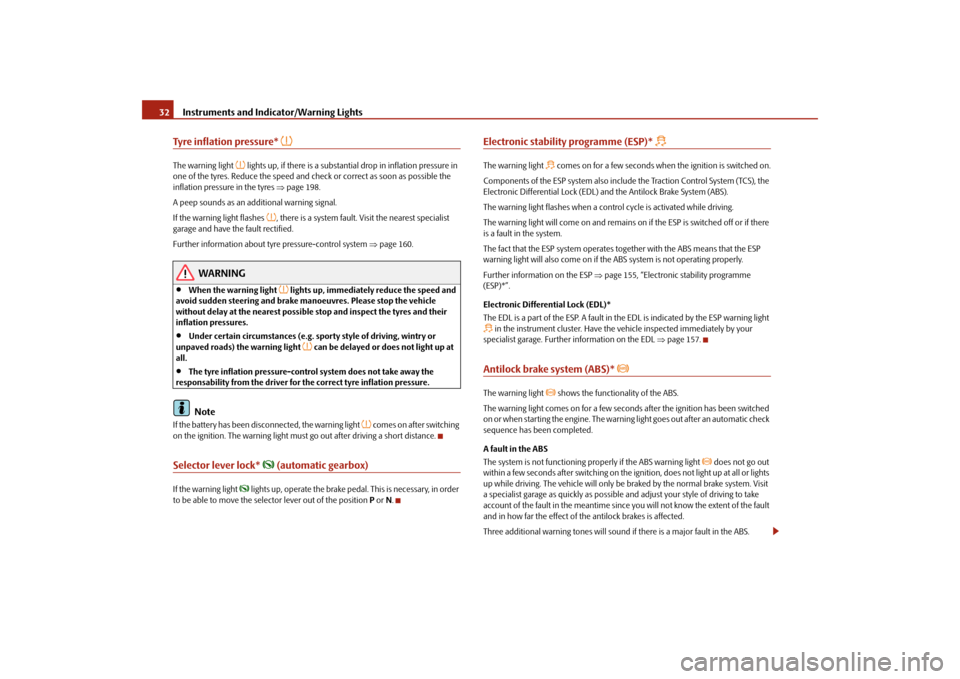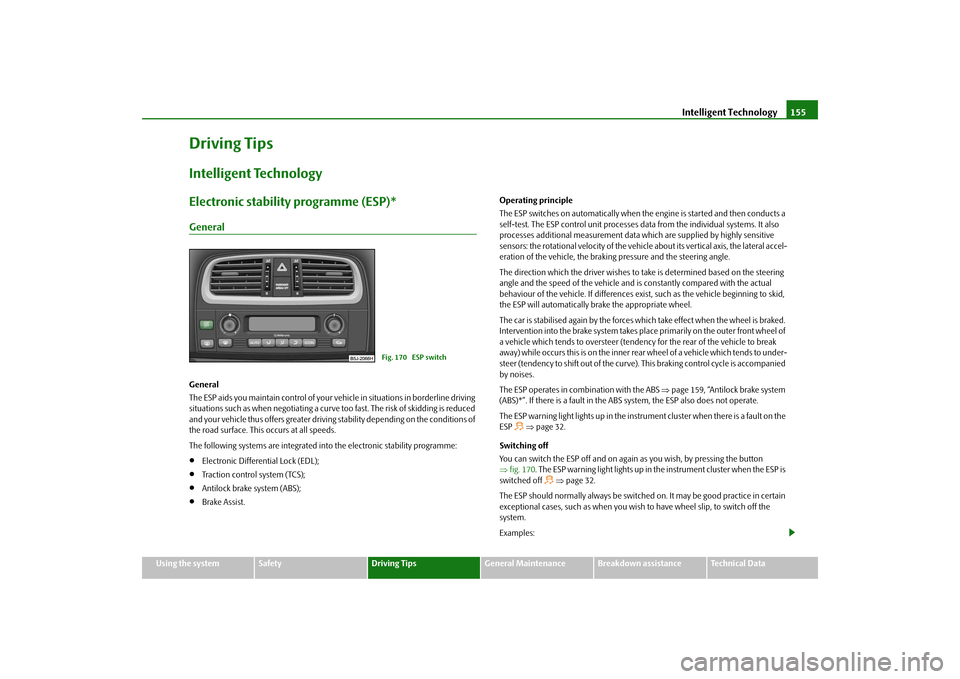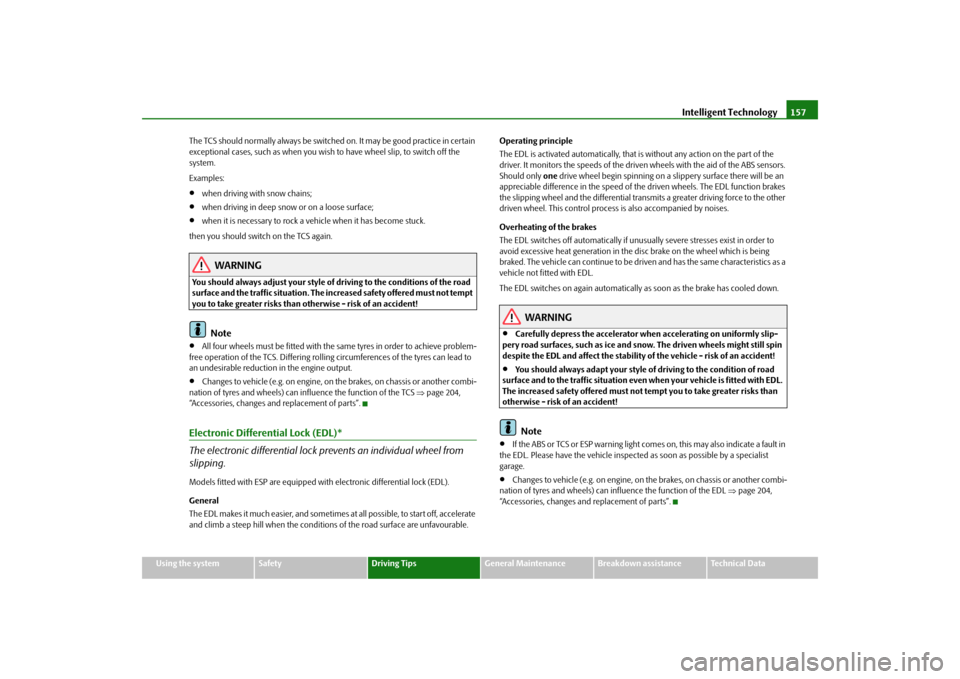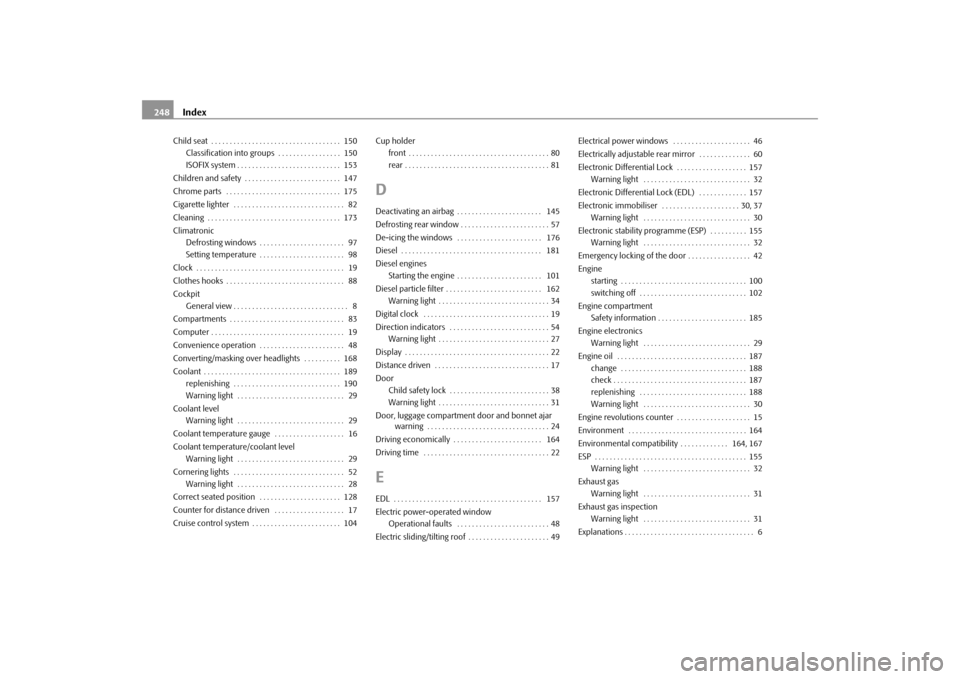differential SKODA FABIA 2009 2.G / 5J Owner's Manual
[x] Cancel search | Manufacturer: SKODA, Model Year: 2009, Model line: FABIA, Model: SKODA FABIA 2009 2.G / 5JPages: 259, PDF Size: 31.99 MB
Page 33 of 259

Instruments and Indicator/Warning Lights 32Tyre inflation pressure*
The warning light
lights up, if there is a substantial drop in inflation pressure in
one of the tyres. Reduce the speed and check or correct as soon as possible the
inflation pressure in the tyres ⇒page 198.
A peep sounds as an additional warning signal.
If the warning light flashes
, there is a system fault. Visit the nearest specialist
garage and have the fault rectified.
Further information about tyre pressure-control system ⇒page 160.
WARNING
•
When the warning light
lights up, immediately reduce the speed and
avoid sudden steering and brake manoeuvres. Please stop the vehicle
without delay at the nearest possible stop and inspect the tyres and their
inflation pressures.
•
Under certain circumstances (e.g. sporty style of driving, wintry or
unpaved roads) the warning light
can be delayed or does not light up at
all.
•
The tyre inflation pressure-control system does not take away the
responsability from the driver for the correct tyre inflation pressure.Note
If the battery has been disconnected, the warning light
comes on after switching
on the ignition. The warning light must go out after driving a short distance.
Selector lever lock*
(automatic gearbox)
If the warning light
lights up, operate the brake pedal. This is necessary, in order
to be able to move the selector lever out of the position P or N.
Electronic stability programme (ESP)*
The warning light
comes on for a few seconds when the ignition is switched on.
Components of the ESP system also include the Traction Control System (TCS), the
Electronic Differential Lock (EDL) and the Antilock Brake System (ABS).
The warning light flashes when a control cycle is activated while driving.
The warning light will come on and remains on if the ESP is switched off or if there
is a fault in the system.
The fact that the ESP system operates together with the ABS means that the ESP
warning light will also come on if the ABS system is not operating properly.
Further information on the ESP ⇒page 155, “Electronic stability programme
(ESP)*”.
Electronic Differential Lock (EDL)*
The EDL is a part of the ESP. A fault in the EDL is indicated by the ESP warning light
in the instrument cluster. Have the vehicle inspected immediately by your
specialist garage. Further information on the EDL ⇒page 157.Antilock brake system (ABS)*
The warning light
shows the functionality of the ABS.
The warning light comes on for a few seconds after the ignition has been switched
on or when starting the engine. The warning light goes out after an automatic check
sequence has been completed.
A fault in the ABS
The system is not functioning properly if the ABS warning light
does not go out
within a few seconds after switching on the ignition, does not light up at all or lights
up while driving. The vehicle will only be braked by the normal brake system. Visit
a specialist garage as quickly as possible and adjust your style of driving to take
account of the fault in the meantime since you will not know the extent of the fault
and in how far the effect of the antilock brakes is affected.
Three additional warning tones will sound if there is a major fault in the ABS.
s3f4.1.book Page 32 Thursday, June 18, 2009 11:07 AM
Page 156 of 259

Intelligent Technology155
Using the system
Safety
Driving Tips
General Maintenance
Breakdown assistance
Technical Data
Driving TipsIntelligent TechnologyElectronic stability programme (ESP)*GeneralGeneral
The ESP aids you maintain control of your vehicle in situations in borderline driving
situations such as when negotiating a curve too fast. The risk of skidding is reduced
and your vehicle thus offers greater driving stability depending on the conditions of
the road surface. This occurs at all speeds.
The following systems are integrated into the electronic stability programme:•
Electronic Differential Lock (EDL);
•
Traction control system (TCS);
•
Antilock brake system (ABS);
•
Brake Assist.Operating principle
The ESP switches on automatically when the engine is started and then conducts a
self-test. The ESP control unit processes data from the individual systems. It also
processes additional measurement data which are supplied by highly sensitive
sensors: the rotational velocity of the vehicle about its vertical axis, the lateral accel-
eration of the vehicle, the braking pressure and the steering angle.
The direction which the driver wishes to take is determined based on the steering
angle and the speed of the vehicle and is constantly compared with the actual
behaviour of the vehicle. If differences exist, such as the vehicle beginning to skid,
the ESP will automatically brake the appropriate wheel.
The car is stabilised again by the forces which take effect when the wheel is braked.
Intervention into the brake system takes place primarily on the outer front wheel of
a vehicle which tends to oversteer (tendency for the rear of the vehicle to break
away) while occurs this is on the inner rear wheel of a vehicle which tends to under-
steer (tendency to shift out of the curve). This braking control cycle is accompanied
by noises.
The ESP operates in combination with the ABS ⇒page 159, “Antilock brake system
(ABS)*”. If there is a fault in the ABS system, the ESP also does not operate.
The ESP warning light lights up in the instrument cluster when there is a fault on the
ESP
⇒page 32.
Switching off
You can switch the ESP off and on again as you wish, by pressing the button
⇒fig. 170. The ESP warning light lights up in the instrument cluster when the ESP is
switched off
⇒page 32.
The ESP should normally always be switched on. It may be good practice in certain
exceptional cases, such as when you wish to have wheel slip, to switch off the
system.
Examples:
Fig. 170 ESP switch
s3f4.1.book Page 155 Thursday, June 18, 2009 11:07 AM
Page 158 of 259

Intelligent Technology157
Using the system
Safety
Driving Tips
General Maintenance
Breakdown assistance
Technical Data The TCS should normally always be switched on. It may be good practice in certain
exceptional cases, such as when you wish to have wheel slip, to switch off the
system.
Examples:
•
when driving with snow chains;
•
when driving in deep snow or on a loose surface;
•
when it is necessary to rock a vehicle when it has become stuck.
then you should switch on the TCS again.
WARNING
You should always adjust your style of driving to the conditions of the road
surface and the traffic situation. The increased safety offered must not tempt
you to take greater risks than otherwise - risk of an accident!
Note
•
All four wheels must be fitted with the same tyres in order to achieve problem-
free operation of the TCS. Differing rolling circumferences of the tyres can lead to
an undesirable reduction in the engine output.
•
Changes to vehicle (e.g. on engine, on the brakes, on chassis or another combi-
nation of tyres and wheels) can influence the function of the TCS ⇒page 204,
“Accessories, changes and replacement of parts”.
Electronic Differential Lock (EDL)*
The electronic differential lock prevents an individual wheel from
slipping.Models fitted with ESP are equipped with electronic differential lock (EDL).
General
The EDL makes it much easier, and sometimes at all possible, to start off, accelerate
and climb a steep hill when the conditions of the road surface are unfavourable.Operating principle
The EDL is activated automatically, that is without any action on the part of the
driver. It monitors the speeds of the driven wheels with the aid of the ABS sensors.
Should only one drive wheel begin spinning on a slippery surface there will be an
appreciable difference in the speed of the driven wheels. The EDL function brakes
the slipping wheel and the differential transmits a greater driving force to the other
driven wheel. This control process is also accompanied by noises.
Overheating of the brakes
The EDL switches off automatically if unusually severe stresses exist in order to
avoid excessive heat generation in the disc brake on the wheel which is being
braked. The vehicle can continue to be driven and has the same characteristics as a
vehicle not fitted with EDL.
The EDL switches on again automatically as soon as the brake has cooled down.
WARNING
•
Carefully depress the accelerator when accelerating on uniformly slip-
pery road surfaces, such as ice and snow. The driven wheels might still spin
despite the EDL and affect the stability of the vehicle - risk of an accident!
•
You should always adapt your style of driving to the condition of road
surface and to the traffic situation even when your vehicle is fitted with EDL.
The increased safety offered must not tempt you to take greater risks than
otherwise - risk of an accident!Note
•
If the ABS or TCS or ESP warning light comes on, this may also indicate a fault in
the EDL. Please have the vehicle inspected as soon as possible by a specialist
garage.
•
Changes to vehicle (e.g. on engine, on the brakes, on chassis or another combi-
nation of tyres and wheels) can influence the function of the EDL ⇒page 204,
“Accessories, changes and replacement of parts”.
s3f4.1.book Page 157 Thursday, June 18, 2009 11:07 AM
Page 249 of 259

Index 248Child seat . . . . . . . . . . . . . . . . . . . . . . . . . . . . . . . . . . . 150
Classification into groups . . . . . . . . . . . . . . . . . 150
ISOFIX system . . . . . . . . . . . . . . . . . . . . . . . . . . . . 153
Children and safety . . . . . . . . . . . . . . . . . . . . . . . . . . 147
Chrome parts . . . . . . . . . . . . . . . . . . . . . . . . . . . . . . . 175
Cigarette lighter . . . . . . . . . . . . . . . . . . . . . . . . . . . . . . 82
Cleaning . . . . . . . . . . . . . . . . . . . . . . . . . . . . . . . . . . . . 173
Climatronic
Defrosting windows . . . . . . . . . . . . . . . . . . . . . . . 97
Setting temperature . . . . . . . . . . . . . . . . . . . . . . . 98
Clock . . . . . . . . . . . . . . . . . . . . . . . . . . . . . . . . . . . . . . . . 19
Clothes hooks . . . . . . . . . . . . . . . . . . . . . . . . . . . . . . . . 88
Cockpit
General view . . . . . . . . . . . . . . . . . . . . . . . . . . . . . . . 8
Compartments . . . . . . . . . . . . . . . . . . . . . . . . . . . . . . . 83
Computer . . . . . . . . . . . . . . . . . . . . . . . . . . . . . . . . . . . . 19
Convenience operation . . . . . . . . . . . . . . . . . . . . . . . 48
Converting/masking over headlights . . . . . . . . . . 168
Coolant . . . . . . . . . . . . . . . . . . . . . . . . . . . . . . . . . . . . . 189
replenishing . . . . . . . . . . . . . . . . . . . . . . . . . . . . . 190
Warning light . . . . . . . . . . . . . . . . . . . . . . . . . . . . . 29
Coolant level
Warning light . . . . . . . . . . . . . . . . . . . . . . . . . . . . . 29
Coolant temperature gauge . . . . . . . . . . . . . . . . . . . 16
Coolant temperature/coolant level
Warning light . . . . . . . . . . . . . . . . . . . . . . . . . . . . . 29
Cornering lights . . . . . . . . . . . . . . . . . . . . . . . . . . . . . . 52
Warning light . . . . . . . . . . . . . . . . . . . . . . . . . . . . . 28
Correct seated position . . . . . . . . . . . . . . . . . . . . . . 128
Counter for distance driven . . . . . . . . . . . . . . . . . . . 17
Cruise control system . . . . . . . . . . . . . . . . . . . . . . . . 104Cup holder
front . . . . . . . . . . . . . . . . . . . . . . . . . . . . . . . . . . . . . . 80
rear . . . . . . . . . . . . . . . . . . . . . . . . . . . . . . . . . . . . . . . 81
DDeactivating an airbag . . . . . . . . . . . . . . . . . . . . . . . 145
Defrosting rear window . . . . . . . . . . . . . . . . . . . . . . . . 57
De-icing the windows . . . . . . . . . . . . . . . . . . . . . . . 176
Diesel . . . . . . . . . . . . . . . . . . . . . . . . . . . . . . . . . . . . . . 181
Diesel engines
Starting the engine . . . . . . . . . . . . . . . . . . . . . . . 101
Diesel particle filter . . . . . . . . . . . . . . . . . . . . . . . . . . 162
Warning light . . . . . . . . . . . . . . . . . . . . . . . . . . . . . . 34
Digital clock . . . . . . . . . . . . . . . . . . . . . . . . . . . . . . . . . . 19
Direction indicators . . . . . . . . . . . . . . . . . . . . . . . . . . . 54
Warning light . . . . . . . . . . . . . . . . . . . . . . . . . . . . . . 27
Display . . . . . . . . . . . . . . . . . . . . . . . . . . . . . . . . . . . . . . . 22
Distance driven . . . . . . . . . . . . . . . . . . . . . . . . . . . . . . . 17
Door
Child safety lock . . . . . . . . . . . . . . . . . . . . . . . . . . . 38
Warning light . . . . . . . . . . . . . . . . . . . . . . . . . . . . . . 31
Door, luggage compartment door and bonnet ajar
warning . . . . . . . . . . . . . . . . . . . . . . . . . . . . . . . . . 24
Driving economically . . . . . . . . . . . . . . . . . . . . . . . . 164
Driving time . . . . . . . . . . . . . . . . . . . . . . . . . . . . . . . . . . 22EEDL . . . . . . . . . . . . . . . . . . . . . . . . . . . . . . . . . . . . . . . . 157
Electric power-operated window
Operational faults . . . . . . . . . . . . . . . . . . . . . . . . . 48
Electric sliding/tilting roof . . . . . . . . . . . . . . . . . . . . . . 49Electrical power windows . . . . . . . . . . . . . . . . . . . . . 46
Electrically adjustable rear mirror . . . . . . . . . . . . . . 60
Electronic Differential Lock . . . . . . . . . . . . . . . . . . . 157
Warning light . . . . . . . . . . . . . . . . . . . . . . . . . . . . . 32
Electronic Differential Lock (EDL) . . . . . . . . . . . . . 157
Electronic immobiliser . . . . . . . . . . . . . . . . . . . . . 30, 37
Warning light . . . . . . . . . . . . . . . . . . . . . . . . . . . . . 30
Electronic stability programme (ESP) . . . . . . . . . . 155
Warning light . . . . . . . . . . . . . . . . . . . . . . . . . . . . . 32
Emergency locking of the door . . . . . . . . . . . . . . . . . 42
Engine
starting . . . . . . . . . . . . . . . . . . . . . . . . . . . . . . . . . . 100
switching off . . . . . . . . . . . . . . . . . . . . . . . . . . . . . 102
Engine compartment
Safety information . . . . . . . . . . . . . . . . . . . . . . . . 185
Engine electronics
Warning light . . . . . . . . . . . . . . . . . . . . . . . . . . . . . 29
Engine oil . . . . . . . . . . . . . . . . . . . . . . . . . . . . . . . . . . . 187
change . . . . . . . . . . . . . . . . . . . . . . . . . . . . . . . . . . 188
check . . . . . . . . . . . . . . . . . . . . . . . . . . . . . . . . . . . . 187
replenishing . . . . . . . . . . . . . . . . . . . . . . . . . . . . . 188
Warning light . . . . . . . . . . . . . . . . . . . . . . . . . . . . . 30
Engine revolutions counter . . . . . . . . . . . . . . . . . . . . 15
Environment . . . . . . . . . . . . . . . . . . . . . . . . . . . . . . . . 164
Environmental compatibility . . . . . . . . . . . . . 164, 167
ESP . . . . . . . . . . . . . . . . . . . . . . . . . . . . . . . . . . . . . . . . . 155
Warning light . . . . . . . . . . . . . . . . . . . . . . . . . . . . . 32
Exhaust gas
Warning light . . . . . . . . . . . . . . . . . . . . . . . . . . . . . 31
Exhaust gas inspection
Warning light . . . . . . . . . . . . . . . . . . . . . . . . . . . . . 31
Explanations . . . . . . . . . . . . . . . . . . . . . . . . . . . . . . . . . . . 6
s3f4.1.book Page 248 Thursday, June 18, 2009 11:07 AM